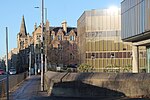Newington is a neighbourhood of southern Edinburgh, Scotland. Developed from the early 19th century, it is an affluent, predominantly residential area.
Located between 1 (1.5km) and 2.5 miles (4km) south of Edinburgh city centre, Newington is bounded to the east by St Leonard's and Prestonfield; to the south by Cameron Toll and Nether Liberton; to the west by Blackford, the Grange, and Sciennes; and to the north by the Southside, Edinburgh. Historically part of the parishes of St Cuthbert's and Liberton in the county of Midlothian, Newington was incorporated into the city of Edinburgh between 1832 and 1896.Originally part of the ancient forest of Drumselch, the lands of Newington were feued by the town council of Edinburgh from 1586. Aside from small developments, the area was predominantly rural until Benjamin Bell purchased the lands in 1805 and began to develop them as a suburb. Around this time, the construction of a new route from Edinburgh's New Town to Liberton via Newington was accelerating the southward development of the city. From the 1850s, bus services connected Newington to the city centre while trams arrived in 1871. Newington station opened to passengers in 1884. By this time, the area was almost enitrely developed. In the latter half of the 19th century, institutions including the Longmore Hospital, the Royal Blind Asylum, and St Margaret's School set up in Newington. Newington station closed to passengers in 1962.
Northern Newington consists of dense early Victorian tenements and Georgian terraces. South of Salisbury Road, these give way to sparser, late Georgian and early Victorian developments, some of which were founded as gated communities. Southern Newington includes Victorian villas and terraces as well as some former industrial buildings.
With a population of around 11,000, Newington today remains an affluent, primarily residential suburb. The area is also one of the most diverse in Edinburgh. Newington houses Edinburgh's only synagogue as well as the headquarters of Historic Environment Scotland and the Causewayside site of the National Library of Scotland.








